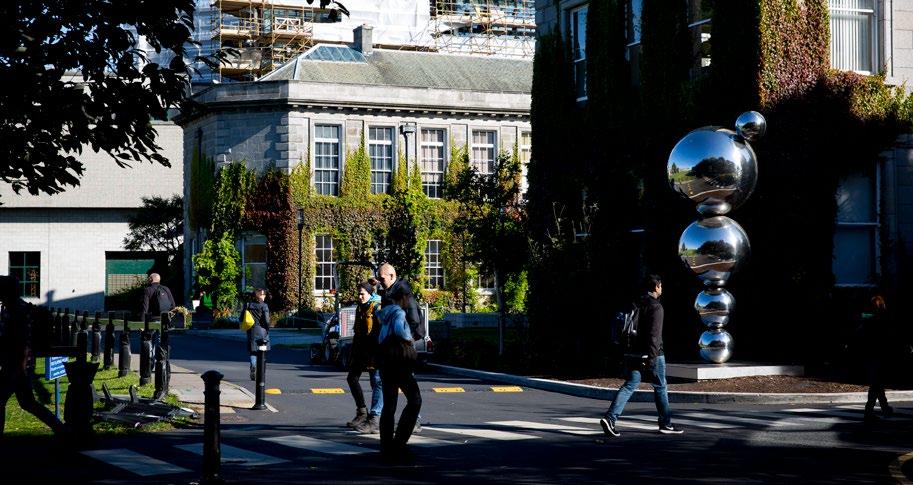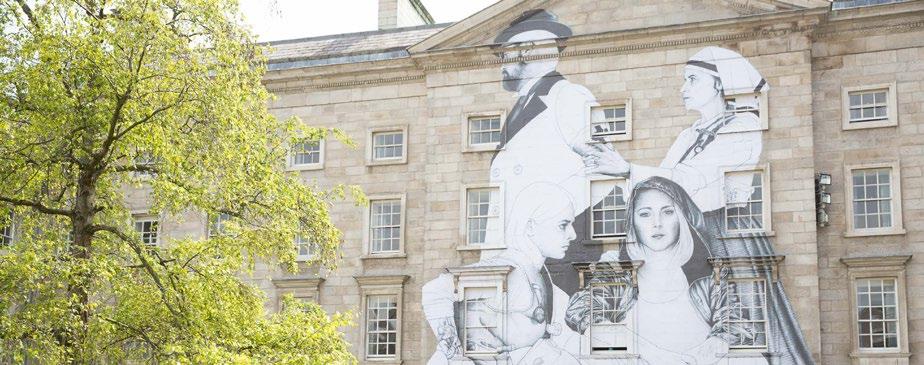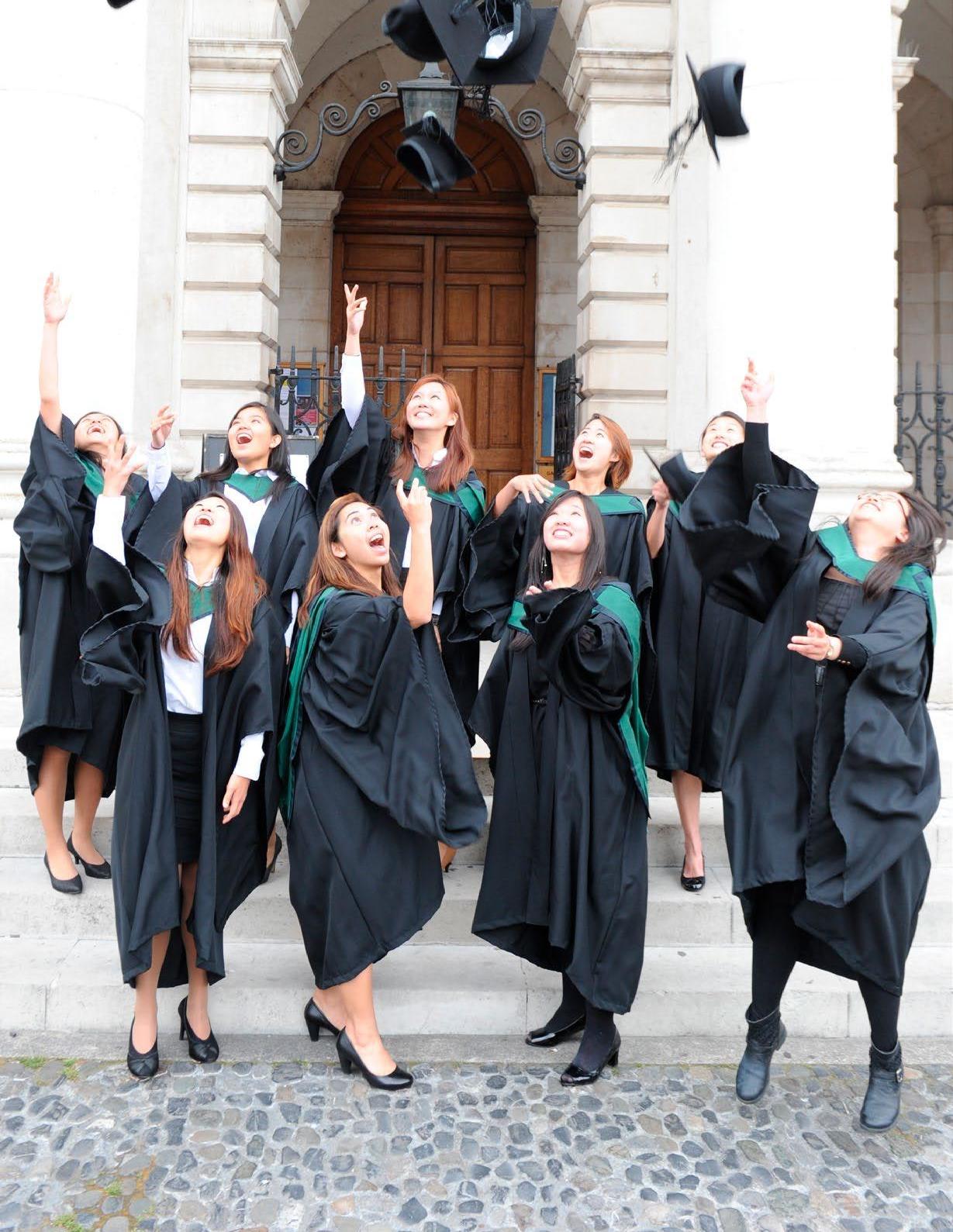
7 minute read
04 Trinity’s Global Relations
from Provost & President's Retrospective Review 2011-21
by Public Affairs and Communications (PAC) - Trinity College Dublin
03
‘embedding philanthropy in the DNA of the university’ and means that priority capital development projects – E3, the Old Library Redevelopment, the Trinity St James’s Cancer Institute – are all now green-lighted; — the prioritising of innovation and entrepreneurship (I&E) in education and research, leading to Trinity become a national and European leader in the formation of campus companies and in undergraduate I&E training (both curricular and co-curricular); — the international recognition of Trinity Access as best practice following the piloting of its Foundation Year by the Universities of Oxford and Cambridge. All of these great initiatives have a full chapter, or sections of chapters, to themselves and rightly so. In my ‘retrospective’ I will focus on what has enabled them – the wiring and architecture behind them, so to speak, because none of these could have happened without the well-coordinated strategizing, structured planning, and tight project execution that have been the hallmarks of this provostship from the start.
Administrative reform and project governance A START Taskforce was established early on in the Provost’s term of office to review, restructure and improve the efficiency of administrative and support services. Key structural changes arising out of this review included the creation of the Academic Registry, the establishment of the Academic Services Division (ASD) and Corporate Services Division (CSD) and the posts of Chief Operating Officer for CSD and Chief Financial Officer for the Financial Services Division (FSD). Equally important was the establishment of comprehensive project management structures for all major initiatives to ensure clear, tight and responsive project governance, with strong controls on reporting lines, budgets, timelines and deliveries. Strategic Plans This restructuring and focus on project management was instrumental in delivering the College’s two Strategic Plans developed under this Provostship. The first Plan, 2014–2019, led by then Vice-Provost, Professor Linda Hogan, was structured around nine goals articulating the University’s vision of global connection, innovative learning and excellent research. Bi-annual reviews continuously monitored progress and each School’s strategic plan was, in turn, aligned to these institutional goals – as a result, by 2019, all targets and goals had either been fully achieved or were close to completion. The second Strategic Plan, 2020–2025 Community and Connection, was developed by Professor Chris Morash and myself. Launched on 10 March 2020, two days before Ireland’s first Covid-19 lockdown, it sets out nine overarching goals across the student experience, including next-generation teaching and learning, impactful research, and ‘one Trinity community’. Its more than 100 actions and targets are in key areas, including flexible programme delivery, digital learning, equality, diversity and inclusion (EDI), and reducing the student-staff ratio to 16:1. The ever-increasing pace of change and the disruption caused by the global pandemic means that a connected vision for our community is more important than ever. These two College Plans have been supported and complemented by strategic plans in different College units, including: Global Relations, Research, Estates and Facilities, the Library, and Innovation and Entrepreneurship. Developing these bespoke strategies for different units has been a key innovation of this decade, which has integrated and reinforced the university’s overall mission and vision.
LEFT – Eilís O’Connell’s sculpture ‘Atoms and Apples’ outside the School of Physics. BELOW – ‘The Volunteers’ by Joe Caslin, commissioned as part of the Trinity Creative Challenge appeared on the front of Sir William Chambers House Number Two in Trinity’s Front Square in the summer of 2017.

Membership of LERU (League of European Research Universities) – In January 2017, Trinity became the 23rd member of LERU, Europe’s leading network of research-intensive universities, which includes Oxford, Cambridge, the Sorbonne and LMU Munich. Membership of LERU is a benchmark of research excellence – as a condition for joining, Trinity underwent a rigorous evaluation of the breadth, quality and impact of its research. LERU is highly influential in EU higher education policy, with major input into programmes such as Horizon 2020, Open Science, Erasmus+ and Open Innovation. The Provost also spent eight years on the board of the European Institute of Innovation and Technology (EIT), helping to cement Trinity’s influence on EU policy.
The Provost’s Council In 2016 the Provost convened a Council of high-achieving and deeply committed Trinity alumni and friends to advise him on the direction of the university. Chaired by Fergal Naughton and including members from all sectors and from all over the world who took the time to come to Trinity for annual meetings (until Covid-19, when they zoomed in), the Provost’s Council has been decisive in the planning, launch and success of Inspiring Generations. Their great commitment and value is evidenced by the fact that the Council will continue to advise and support the incoming Provost, helping to spearhead future transformative initiatives for the University.
Sustainability Both Strategic Plans position climate emergency and biodiversity loss as key challenges which universities must confront and lead on. In 2013 Trinity became the first university in a European capital city to join the Green Campus programme and in 2017 we joined the International Sustainable Campuses Network. The Provost’s Advisory Committee on Sustainability has driven sustainability goals and targets over the past four years and a Climate Action Team is now in place to create our first Climate Action Plan. A Sustainable Procurement policy and guidelines, the revised Waste policy, our Green Labs programme and the nine new subcommittees working on sustainability themes are just four of the initiatives implemented over the past few years. In 2020 our rewilding of College Green with wildflower meadows received huge national and international attention.
Trinity Creative Challenge And finally, a word on the Provost’s championing of creativity. Three rounds of the Trinity Creative Challenge ran between 2015 and 2018. This catalysing initiative funded thirteen creative arts projects across multiple platforms, including performance, visual art, music, film, design, animation, gaming and creative technologies. It was shortlisted for the 2016 Allianz Business to Arts Awards in the Jim McNaughton Perpetual Award for Best Commissioning Practice category. But perhaps the greatest manifestation of the support for artistic creativity this decade has been the commissioning of new portraits and sculptures to adorn the college walls and walks. The Provost commissioned numerous portraits of women leaders, notably the full-length portrait of our former Chancellor Mary Robinson in the Dining Hall, former Vice-Provost Linda Hogan, and former Registrar and current Pro-Chancellor Shane Allwright, while Eilís O’Connell’s incandescent sculpture outside the School of Physics ‘Atoms and Apples’, commemorating Ernest Walton’s splitting of the atom, inspires with its uplifting fusion of science, nature and art.
04
Trinity’s Global Relations
Professor Juliette Hussey, Vice-President for Global Relations
At the beginning of his term of office, the Provost created a college officer position of VicePresident for Global Relations, tasked with the responsibility of setting up a team and developing the first Global Relations Strategy (GRS1).
RIGHT – Singaporean students of physiotherapy celebrate graduating in Trinity as part of the Trinity Singapore Institute of Technology programme. Professor Jane Ohlmeyer held this position from 2011–14 and I have held it since 2014. The strategy set the direction of travel with an overall ambition of developing partnerships with leading universities around the world and the global recruitment of excellent students to study in Trinity. Building on a long and strong record of internationalisation in terms of research partnerships, the time was right to consider educational partnerships. There were two main areas of focus: student exchanges and joint educational programmes.
Student exchanges Student exchanges with leading universities around the world provide opportunities for students to undertake part of their programme overseas; typically in undergraduate programmes this occurs in the third year. Increasingly students select universities, not just on the reputation of a university and programme of study, but on the institutions that it partners with. Overseas experience is often regarded as a differentiator in terms of graduate opportunities. Developing globally aware graduates is key to the global challenges ahead. Working across cultures, countries and languages is important in preparing young people with the skills and experience for their lives ahead. These are articulated in the Trinity Graduate Attributes.
≥ Ten years ago there was an absence of international educational partnerships leading to dual and joint degrees. Now Trinity has robust experience in developing a dual degree with a leading university and a joint degree delivered mainly through TNE (transnational education).











